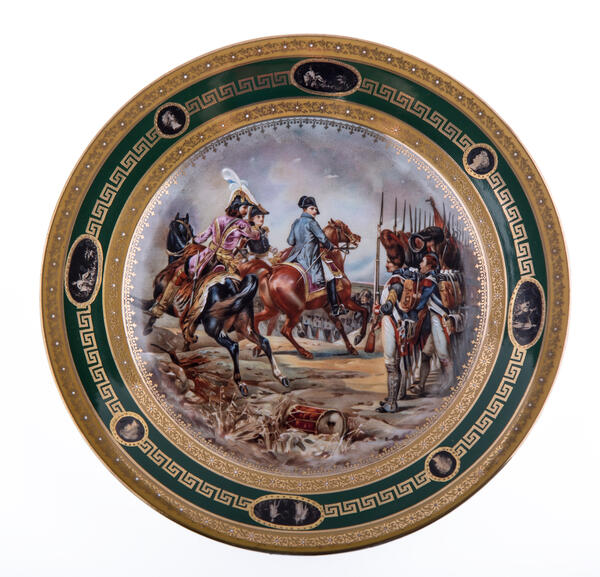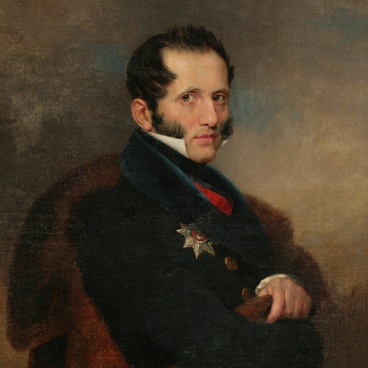A porcelain plate with one of the scenes of the “Napoleonic Wars” entered the museum from the Karacharovsky estate of the Counts Uvarov in 1918. The equestrian emperor of the French and his two adjutants are depicted in front of the soldiers. A giant 5×5m painting from Versailles “Napoleon in front of the old Guard on the battlefield of Jena” is reproduced in miniature in the painting at a small plate on a mirror with 20 cm in diameter. It was painted by a popular French battle artist and diplomat Horace Vernet (1789-1863). He became widely known as the author of huge pathetic canvases created in the 1830s and 50s by order of Louis Philippe and Napoleon III. Vernet possessed the greatest powers of observation and analytical mind, the accuracy of reflecting facts. The Battle of Jena took place on October 14, 1806, simultaneously with the Battle of Auerstedt in Prussia. Both battles took place between the army of Napoleon I and the Prussian troops of King Frederick. Within one day, Napoleon’s army defeated and virtually destroyed the Prussian army.
The first decades of the XIX century were marked by a romantic fascination with the personality of the “evil genius” Napoleon Bonaparte. Of the many paintings dedicated to the emperor, Horace Vernet’s battle paintings were most often transferred to the porcelain plates of European factories throughout the XIX and at the beginning of the XX century. The back of our plate has a stamp “N under the crown”. It is known that it belonged to the Capodimonte porcelain factory (Capo di Monte) in Naples. It was founded in 1743 by the Spanish King Charles III Bourbon. During the Napoleonic era, this enterprise fell into disrepair and ceased to exist in 1819. However, other porcelain establishments also produced items under the brand of this factory. In the second half of the XIX century, there were several of them in Naples. In addition to the stamp, there is an erroneous inscription on the back of the plate in question: “Bataille de Friedland” (Battle of Friedland). This plot, also based on a painting by Horace Vernet, is presented in the museum on a plate paired with it, and also with a confused inscription. The design of the fields is executed in the Empire style of the Napoleonic era: story medallions, Greek ornament “meander”.
The first decades of the XIX century were marked by a romantic fascination with the personality of the “evil genius” Napoleon Bonaparte. Of the many paintings dedicated to the emperor, Horace Vernet’s battle paintings were most often transferred to the porcelain plates of European factories throughout the XIX and at the beginning of the XX century. The back of our plate has a stamp “N under the crown”. It is known that it belonged to the Capodimonte porcelain factory (Capo di Monte) in Naples. It was founded in 1743 by the Spanish King Charles III Bourbon. During the Napoleonic era, this enterprise fell into disrepair and ceased to exist in 1819. However, other porcelain establishments also produced items under the brand of this factory. In the second half of the XIX century, there were several of them in Naples. In addition to the stamp, there is an erroneous inscription on the back of the plate in question: “Bataille de Friedland” (Battle of Friedland). This plot, also based on a painting by Horace Vernet, is presented in the museum on a plate paired with it, and also with a confused inscription. The design of the fields is executed in the Empire style of the Napoleonic era: story medallions, Greek ornament “meander”.



